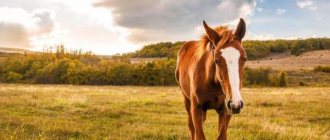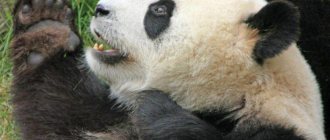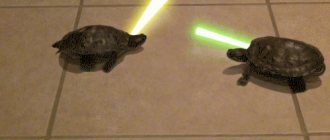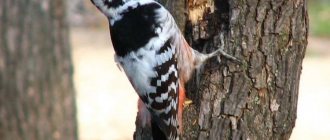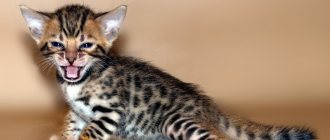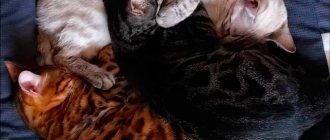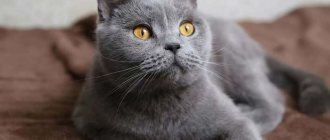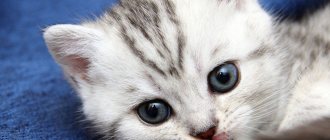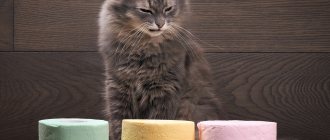The Bengal cat is a rare but popular breed of cat among connoisseurs of the beauty and grace of large representatives of the cat family. The breed has earned special love from those who admire exotic breeds, including hybrids of wild and domestic cats. Since keeping a panther or tiger in the house is, to put it mildly, an extravagant and inhumane idea, a mini “leopard” will be an excellent alternative.
The Bengal cat has absorbed the best features of its ancestors: attractive appearance, intelligence, curiosity and friendliness. In this article we will tell you: what is remarkable about this breed, how much a Bengal kitten costs, what kind of character the animals have, what to feed them and how to care for them.
Characteristics of the Bengal cat - character and behavior
Fluffy beauties with spots like a leopard combine in their temperament the features of a wild predator and a pet. They are smart, sociable and playful. Their upbringing needs to be constantly done, since curious and smart Bengals need mental stimulation and stable control. Thanks to their intelligence, they remember any commands well and can be trained like dogs.
Photo: @dmytro.shapko/Instagram
In general, the personality of the Bengal cat is very similar to that of a dog. She also loves to carry toys and other things and will readily defend her owner and territory. In addition, these leopard-like cats are extremely talkative. You will have to communicate with them almost all the time, reporting where the owner is going and why. And the pet will always respond, making several dozen different sounds.
Diet
Typically, wild Bengal cats feed on small game, such as mice, rats, hamsters, rabbits, squirrels or birds.
During periods of hunger, the animal can hunt various reptiles, insects, and small animals. Sometimes they can fish, but most often they hunt on land, since their color helps them in such conditions.
If a wild animal finds the eggs of other animals, then it will eat them too.
For domesticated wild Bengal cats, you need to choose a special diet. It must be balanced and contain all the necessary vitamins, minerals, and macroelements.
The animal can be fed with special balanced feed. But it is very important not to focus on them, but to give them more meat and other natural foods.
Industrial feed
The digestion of Bengals is quite difficult to tolerate a change in diet. Buy good, expensive industrial food. It is completely unreasonable to buy a pet for a lot of money and then spoil its health with bad food.
The food must be of the highest quality. It is best to ask the breeder what food you can feed your little leopard. It is important that a cat on such a diet always has fresh water. It is best to buy electric bowls in which the water is constantly renewed. This will resemble a pond or stream and will inspire more confidence.
Natural food
But it is best to feed the animal with natural food. Many people believe that if you feed a predator meat, it will become even more wild. This is wrong. Such an animal really needs raw meat, since only through it can the cat receive the necessary elements.
The meat can be anything: chicken, beef, fish. You can add porridge (without milk) and boiled vegetables to your diet.
Wild bengal in an aviary
Description of the breed
Like other purebred cats, the Bengal has a breed standard, which is important to consider when purchasing a pet.
Appearance - what a Bengali looks like
The Bengal's head is wide, resembles a wedge with more rounded contours, and is proportional to the body. The shape of the skull with a slight convexity in the area of the ears and the back of the head. The ears are short, widened towards the base, the tips are round and set wide apart. The eyes are close to oval in shape, deep-set, large and widely spaced.
Photo: @life_as_a_bengal/Instagram
The transition from forehead to muzzle is smooth, the bridge of the nose is located slightly higher than eye level. The muzzle is wide, slightly elongated, with fairly clear and high cheekbones. The nose is wide, the lobe looks slightly inflated. The jaws are powerful. The transition from head to neck has a smooth curve, and the neck itself is proportional to the head and muscular.
Photo: @kazuki_the_bengal/Instagram
The body is elongated and strong, the muscles are powerful and clearly visible when moving. The length of the paws is average, but the hind legs are slightly longer than the front ones. The pads are large and round in shape. The finger joints protrude slightly. The tail is medium in length, quite thick, but tapers towards the tip. The tip itself is rounded.
Photo: @brearleybengalboys/Instagram
Size
An adult mini leopard has a length from 35 to 46 cm and a height (at the withers) from 20 to 25 cm. Males grow up to the age of 2 years, and females - up to 9 months.
Bengal cat with a person Photo: @bengal.belva/Instagram
Weight
The average weight for a Bengal ranges from 4 to 9 kg. Moreover, most often they weigh 5-6 kg, since they are distinguished by mobility.
Wool
Bengal cats have short hair, only in kittens it is slightly longer than average. The fur itself is dense, fits tightly to the body, and is distinguished by its thickness and softness to the touch.
Colors
The main shade of Bengal fur can be represented by one of 3 options: gold, silver or snow. Two of them (gold and snow) have an internal classification.
Gold or brown color is most common and can be represented by the following shades:
- Light beige.
- Brown with a slight yellowish tint.
- Bronze.
- Red and gold.
- Chocolate.
- Kashtanov.
- Brick red.
- Dark brown.
Golden and silver Bengals have green or yellow eyes.
Snow Bengal is a fairly rare color, it includes:
- Lynx - at birth, kittens have a white tint, which acquire a pattern by the age of one year. The eyes of such cats have a bright blue iris.
- Minx - the main color is cream or gray, the pattern is bright in childhood, but in an adult pet the contrast is reduced. The eyes have a blue or aquamarine tint.
- Sepia – The base color is light, maybe slightly orange or golden, and the spots or rosettes are not bright. The eyes may be yellow, golden or slightly green.
Bengal cats with spotted and marbled patterns.
Bengals are also distinguished by the pattern on their coat:
- Rosette - with “rosettes”, the color inside of which is darker than the background; the rosettes themselves can be closed or not closed.
- Spotted - with solid spots.
- Marble or striped - a pattern of horizontal stripes.
Separately, it should be said about sockets: they come in different shapes. Depending on the appearance, there are paw print, donut, arrow, fog rosettes, cluster rosettes and chain rosettes. See the picture below for more details.
There are also two extremely rare colors: blue and charcoal and black.
Charcoal Bengal
Basic information
| Breed name: | Bengal cat |
| Country of origin: | Southeast Asia |
| Period of appearance of the breed: | 1961 |
| Type: | Home |
| Average weight: | 2.5 - 7 kg |
| Height at withers: | 15-30 cm |
| EMS code: | BEN |
| Average life expectancy: | 12 – 25 years |
| Prices for kittens: | 1000 — 2500 $ |
| The most popular nicknames: |
Are Bengal cats hypoallergenic or not? How often do they shed?
Bengal cats are classified as hypoallergenic. They received this title due to the fact that dandruff, which provokes an allergic reaction in people predisposed to it, is formed in a minimal amount.
Savannah (left) and Bengal (right) Photo: @giguerecats/Instagram
Another allergen, a protein from a cat’s saliva, rarely comes into contact with humans and the cat’s fur due to the cat’s lack of habit of constantly grooming itself and licking its owner. Also, being a short-haired breed, Bengals shed very little, and during the shedding season, brushing once a week is sufficient for grooming.
Métis
There are significant features in breeding the Bengal cat breed. They currently do not have officially recognized mestizos due to the ban of felinological communities on crossing with other species. There are also few unofficial “derivatives” based on Bengals; sometimes it is difficult to recognize and distinguish them from the real ones. The recently bred cashmere (or silk) Bengal with long hair, which has become more and more loyal to specialists over the years, has shown that there is a “dormant” gene for long hair in the gene pool of the hybrid. A special text is dedicated to the mixed breeds of the Bengal cat.
Are Bengals a friendly breed?
These cats are quite friendly, but will not happily greet strangers. At first they will be distrustful, but they will quickly get used to the guest and will fawn on him.
Photo: @leonardo_the_bengal/Instagram
It is also worth noting that the Bengal breed is not known for its aggression; it does not have this quality at all. Even if cruelty is shown by an adult or child, the likelihood of a retaliatory attack is almost zero. There is a greater chance that the cat will try to dodge the unwanted influence on itself and run to hide in a secluded place.
Tips for choosing a kitten
The Bengal cat is a fairly expensive breed, so you shouldn’t chase a low price and buy a kitten secondhand, without documents, on dubious online bulletin boards or a bird market. It is best to contact a nursery or breeder with a good reputation. Only there you can find Bengal kittens that fully meet the standards.
What is important:
- a Bengal kitten must have documents: a pedigree indicating the generation, and a veterinary passport with the first vaccinations;
- a good breeder will not sell a kitten under two months old;
- a Bengal kitten at the age of sale weighs about a kilogram;
- the kitten should be active, playful, with clean eyes and ears, shiny shiny fur;
- he should not hiss and break out of his hands - a poorly socialized kitten will be wild and isolated;
If you are purchasing a kitten for exhibitions or, especially, breeding, pay attention to the absence of defects and defects.
How to cope with loneliness
Bengals are very dependent on their usual society. Being infinitely loyal, they strive to always accompany their person. They will happily keep the owner company, either lying on the sofa or bed, or preparing food in the kitchen or relaxing in the bathroom. Any separation from the owner is stressful for the pet, and lack of attention will make the animal distrustful and wild. Therefore, these cats are not suitable for those who are constantly at work or study.
Photo: @kara_ohhh/Instagram
Upbringing. Training
The independent nature of Bengals does not mean that they will not obey. Using short, strict “no” orders in parallel with a gentle pinch on the neck that is understandable to the animal (this is what cat mothers do when raising kittens), you can achieve compliance with order. The easiest way to reach a consensus on following the rules is based on the instincts and desires of the pet itself. To do this, at the first “observational” stage you need to notice how the cat behaves. Habits, preferences, behavioral characteristics are then used in choosing educational methods.
More than other cats, Bengal cats will not tolerate violence, so pedagogy a priori involves encouragement, affection, and is built on complete trust. Educational processes must begin at a very tender age - read the article “Upbringing and training” about this.
Potential Health Problems
Most Bengals are distinguished by good health, obtained thanks to the genetic data of their wild ancestors. But there are a number of diseases that you may encounter:
- Digestive disorders and food poisoning.
- Diseases of the gastrointestinal tract that are inflammatory in nature.
- Cardiomyopathies.
- Polycystic kidney disease.
- Flat sternum syndrome (genetic defect).
- Leukemia.
- Pathologies of the endocrine system (hormonal disorders, often found in unsterilized pets).
- Dry nose syndrome.
- Urolithiasis disease.
Photo: @bengal_lys/Instagram
Who are Bengal pussies suitable for?
Despite the increased popularity of pet leopards, these pets are not suitable for everyone. Good reviews about Bengal cats can be read on forums, mainly from experienced owners. Pussies with such a character are not suitable for people who love peace and quiet, since in this case the pet will require a lot of attention. Bengals are actively purchased by allergy sufferers, since the presence of a pet leopard in the apartment reduces the likelihood of allergic attacks.
Need for care
For the owner of a Bengal cat, caring for your pet will not be a serious problem. It will be enough to comb the coat once every couple of weeks with a soft brush, and trim the nails several times a month. It is enough to wash your pet as needed; most of the time you will have to make sure that the cat does not get into the water. And caring for your eyes and ears involves monthly examination and monitoring of their condition.
Photo: @mars_mr_cat/Instagram
But there are several features:
- A leopard-colored pet's tray should always be clean - they will not go near a dirty area, even if they are in great need.
- It is necessary to brush your teeth weekly from the moment the kitten arrives in the house to prevent the formation of tartar and oral diseases.
- It is imperative to equip a corner for the pet - its territory must be inviolable for the owner and be a bed or a house (the second option is a priority).
- The quality of food should always be monitored especially carefully, since the breed has sensitive digestion.
Pregnancy and childbirth
The gestation period for the Bengal cat is normal for the species - about 65 days. They count down the days from the moment of successful mating, which will be indicated by such indirect signs as the cessation of estrus, changes in behavior. An ultrasound confirms the presence of kittens in the uterus after 15 days. Bengal cats usually give birth on their own; assistance may be needed during the first lambing. However, it is recommended to undergo an examination and adhere to the advice of a veterinarian. You can read more about pregnancy and childbirth.
Read more about Bengal pregnancy
Maintenance cost
In order for a pet to live a full and comfortable life, the right approach to its maintenance is necessary. But you should immediately take into account that with a Bengal it will not be cheap.
Nutrition
You can feed your pet both natural products and food. In the first option, the cost of the diet is calculated by the pet owner. And if preference is given to feed, purchasing elite and high-quality products will cost about 5-10 thousand rubles. per month.
Photo: @bengal_vom_kleinen_himmel/Instagram
Veterinary
Standard vaccinations in accordance with the calendar will cost from 1 to 4 thousand rubles. Any other expenses are determined by the specialist and the owner as necessary.
Grooming
A visit to a salon with a Bengal is not necessary, but it is advisable when preparing for an exhibition. One trip to the groomer can cost from 2 to 4 thousand rubles.
Photo: @littlewild.life/Instagram
Exhibitions
Participation in exhibitions together with a representative of the Bengal breed will cost the owner from 7 to 23 thousand rubles if the event takes place in Russia. The amount depends on the level of the exhibition and a number of other factors, but it does not include travel to the event venue, accommodation and food for the owner and pet.
Breeding
Puberty in “domestic leopards” ends at 7–9 months. However, mating can only begin after 1 year. The female is brought to the male's territory. The producer must have excellent breed characteristics. Both parties are required to provide test results for sexually transmitted infections. Participants in the process must be completely healthy.
Knitting is carried out as follows:
- Animal owners enter into an agreement on the rules of the procedure and the possibility of re-mating in case of failure.
- 2–4 days are allotted for everything.
- The “groom” and “bride” are locked in a separate room, food and water are left for them. It is better not to disturb the couple, but in the event of a conflict, the fire of passions should be extinguished immediately.
- If the cat becomes calmer, it means the mating was successful. Pregnancy can be confirmed by ultrasound after a few weeks.
The Bengal cat stays in an interesting position for 60–70 days. The owner’s task is to provide the pet with peace, surround it with care, protect it from stress, and feed it well.
A low cardboard box is suitable as a birthing nest. A soft diaper is laid on the bottom and the cat is given the opportunity to get used to the new place and get used to it.
The birth process usually begins at night. 3-5 days before the expected date of birth, the owner must monitor the expectant mother around the clock in order to react in time and call the veterinarian if complications arise.
The cat should not be left alone until the birth is over. The owner may have to free the baby from the amniotic sac.
Kittens are born at intervals of 30–50 minutes. A litter usually consists of 3-6 kittens.
History of the breed
The initial, unplanned attempt to breed the Bengal occurred in the 60s. At that time, a resident of the United States, Jane Mill, who had a leopard cat and a domestic black cat, accidentally received offspring from her pets. But the first result of crossing was not crowned with success.
Photo: @brearleybengalboys/Instagram
Ms. Mill resumed her attempts at targeted selection of the graceful domestic predator in 1980. Through mating and painstaking work, Jane received full-fledged pets. She bred not only an animal capable of a full, long life, but also one that produces offspring, which is important for further breeding.
Photo: @bangkokbengalcats/Instagram
The first appearance of the breed at the exhibition happened in 1987, and already in 1991 it was registered in the official list of cat breeds. At this time, the final breed standard appeared and Bengals were allowed for further exhibitions and breeding.
Features of Bengals
The characteristics of Bengal cats and cats are due to the origin of this rather young hybrid breed. Bred by intergeneric crossing with prionailurus bengalensis, the domestic animal has a unique color, inherited from Asian leopard cats, and also has a special character. The advantages, in addition to the magnificent color, include:
- sociability, playfulness;
- the ability to get along, while maintaining dominance, with other animals (not birds or rodents);
— cleanliness;
- ease of care and feeding.
Among the disadvantages, breeders and ordinary cat lovers cite the habit of meowing loudly, a tendency to inflammation of the gastrointestinal organs, as well as the high cost of a noble breeding breed. About the size and weight of the Bengal leopard cat - in a separate text.
Read more about the size and weight of Bengals
Interesting facts about Bengal cats
It is useful for future owners to learn about some of the features of this breed:
- Representatives of the Bengal breed have an unusual phenomenon - fuzzy or phasing. It lies in the fact that from 1.5 months of life, kittens experience regrowth of outer coat. Because of this, the pattern becomes blurry and the kitten looks fluffier than it should. But by 5-9 months this stage of growing up passes.
- Some Bengals inherit the glitter or “glitter gene.” Thanks to it, the pet's fur can have a sparkling tint, which stands out most when exposed to sunlight.
- Pets of this breed have a special love for everything shiny, and therefore love to collect and hide sparkling things. When keeping a Bengal, it is necessary to hide jewelry so that your pet does not take them to a secluded corner.
- You can walk down the street with Bengal cats just like with dogs. Charming pets will happily go for a walk on a leash or harness, but letting them go is unacceptable.
How to choose a kitten
The Bengal cat is an elite breed, which means it is expensive. If you want to buy a purebred, healthy kitten, go past the ads on AVITO and similar sites. Look for reliable nurseries with a license, only in this case you can count on the pet to be a real Bengal with a pedigree.
When purchasing a baby, carefully study the registration documents and the generation to which he belongs. For home keeping it is better to take a Bengal F4-F7.
The optimal age for transferring a kitten to a new home is 10-12 weeks.
A healthy baby should look clean and tidy, weigh at least 1 kg, be playful and sociable. The mucous membrane of the eyes is clean, without crusts or discharge, the area under the tail is dry.
The breeder must also provide a vaccination passport indicating the vaccinations given.
The condition of the coat is also important. It should be smooth, shiny, and the color should correspond to the age and breed standard. This point is important if the owner is focused on a Bengal show career.
Photo
Bengal cat Thor
Rani Kuchkov, the owner of a Bengal cat named Thor, recently posted a photo of his “eared cat” on Instagram. Within a few days, the number of visitors to his page exceeded 50 thousand people. The emerald green-eyed Thor, with his silky coat covered in spots, is recognized as the most beautiful pet leopard in the world.
Mr. Kuchkov said that he and his entire family are literally ready to serve their Bengal, receiving a lot of love and attention in return. Thor is ready to talk with his household members all day long. But your pet can become seriously angry if its meows are ignored.
This cat loves to jump on the walls before going to bed, and always greets guests with a cheerful purr.
Owner reviews
Bengal owners proudly note that their pets are loving and loyal. They are impressed by the responsiveness of furry companions and hypoallergenicity. Also, many note that Bengal cats are clean and show moderate character, which makes caring for them the most pleasant and calm process. Bengal owners advise choosing a Bengal kitten for those people who are ready for an active and loving animal.
Photo: @murphys_pawprints/Instagram
Advantages and disadvantages
Advantages of the breed:
- attractive exterior;
- calm character;
- friendliness;
- love;
- high intellectual abilities;
- ease of care;
- excellent health;
- intelligence;
- ability to train;
- good manners.
Flaws:
- representatives of the F1-F3 generation have a bad character;
- waywardness;
- desire to defend personal boundaries in a slightly aggressive manner;
- a developed hunting instinct poses a threat to small animals, fish and birds;
- high cost.

